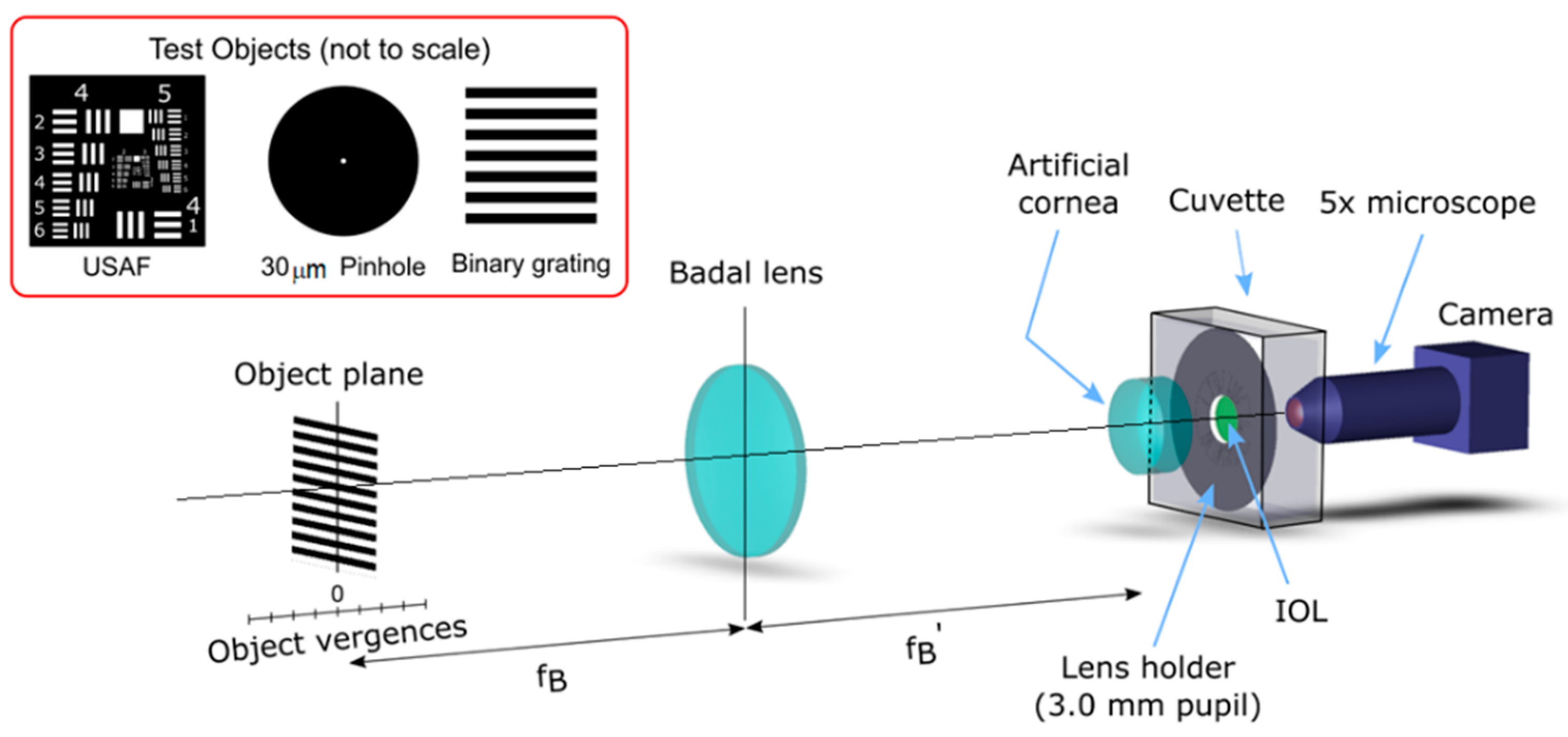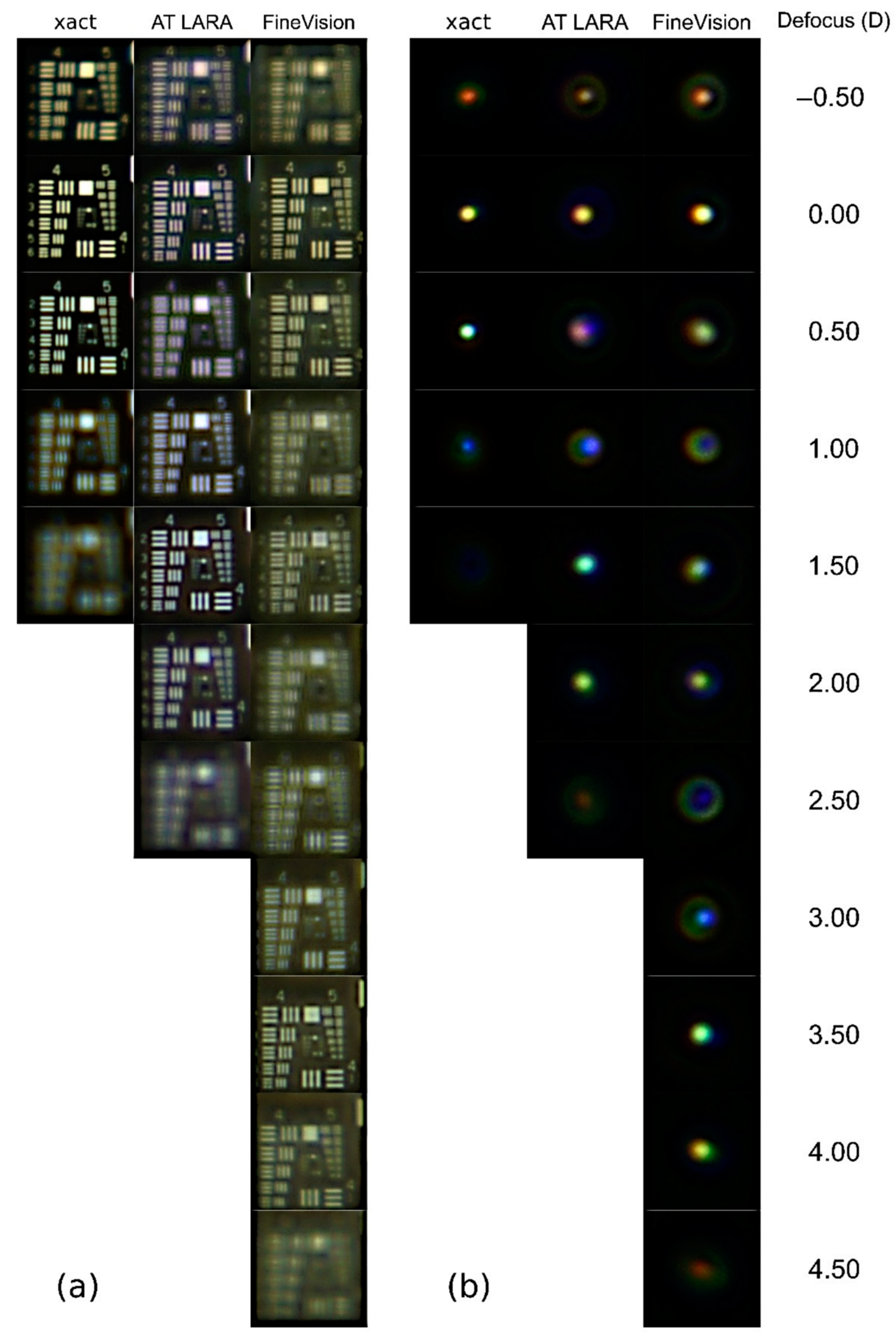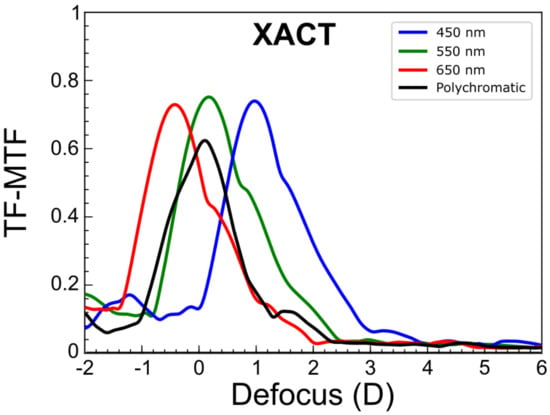In Vitro Chromatic Performance of Three Presbyopia-Correcting Intraocular Lenses with Different Optical Designs
Abstract
:1. Introduction
2. Materials and Methods
2.1. IOL Designs Studied
2.2. Experimental Setup and Metrics
3. Results
3.1. TF-USAF and PSF Images
3.2. Polychromatic TF-MTF
4. Discussion
5. Conclusions
Author Contributions
Funding
Institutional Review Board Statement
Informed Consent Statement
Data Availability Statement
Conflicts of Interest
References
- Zvorničanin, J.; Zvorničanin, E. Premium intraocular lenses: The past, present and future. J. Curr. Ophthalmol. 2018, 30, 287–296. [Google Scholar] [CrossRef]
- Salerno, L.C.; Tiveron, M.C., Jr.; Alió, J.L. Multifocal intraocular lenses: Types, outcomes, complications and how to solve them. Taiwan J. Ophthalmol. 2017, 7, 179–184. [Google Scholar]
- Rampat, R.; Gatinel, D. Multifocal and extended depth-of-focus intraocular lenses in 2020. Ophthalmology 2020, 128, e164–e185. [Google Scholar] [CrossRef]
- Gatinel, D.; Pagnoulle, C.; Houbrechts, Y.; Gobin, L. Design and qualification of a diffractive trifocal optical profile for intraocular lenses. J. Cataract Refract. Surg. 2011, 37, 2060–2067. [Google Scholar] [CrossRef]
- Cochener, B.; Vryghem, J.; Rozot, P.; Lesieur, G.; Chevalier, J.P.; Henry, J.M.; David, T.; Lesueur, L.; Gatinel, D.; Ganem, C.; et al. Clinical outcomes with a trifocal intraocular lens: A multicenter study. J. Refract. Surg. 2014, 30, 762–768. [Google Scholar] [CrossRef] [Green Version]
- Poyales, F.; Garzon, N. Comparison of 3-month visual outcomes of a spherical and a toric trifocal intraocular lens. J. Cataract Refract. Surg. 2019, 45, 135–145. [Google Scholar] [CrossRef]
- MacRae, S.; Holladay, J.T.; Glasser, A.; Calogero, D.; Hilmantel, G.; Masket, S.; Stark, W.; Tarver, M.E.; Nguyen, T.; Eydelman, M. Special report: American Academy of Ophthalmology Task Force consensus statement for extended depth of focus intraocular lenses. Ophthalmology 2017, 124, 139–141. [Google Scholar] [CrossRef] [Green Version]
- Chae, S.H.; Son, H.S.; Khoramnia, R.; Lee, K.H.; Choi, C.Y. Laboratory evaluation of the optical properties of two extended-depth-of-focus intraocular lenses. BMC Ophthalmol. 2020, 20, 53. [Google Scholar] [CrossRef] [Green Version]
- Łabuz, G.; Papadatou, E.; Khoramnia, R.; Auffarth, G.U. Longitudinal chromatic aberration and polychromatic image quality metrics of intraocular lenses. J. Refract. Surg. 2018, 34, 832–838. [Google Scholar] [CrossRef] [Green Version]
- Lee, Y.; Łabuz, G.; Son, H.S.; Yildirim, T.M.; Khoramnia, R.; Auffarth, G.U. Assessment of the image quality of extended depth-of-focus intraocular lens models in polychromatic light. J. Cataract Refract. Surg. 2020, 46, 108–115. [Google Scholar] [CrossRef]
- Kohnen, T.; Suryakumar, R. Extended depth-of-focus technology in intraocular lenses. J. Cataract Refract. Surg. 2020, 46, 298–304. [Google Scholar] [CrossRef]
- Baur, I.D.; Khoramnia, R.; Weindler, J.; Naujokaitis, T.; Poompokawat, P.; Auffarth, G.U. Clinical Outcomes of a New Hybrid Monofocal IOL With Extended Depth of Focus. J. Refract. Surg. 2021, 37, 601–608. [Google Scholar] [CrossRef] [PubMed]
- Tañá-Sanz, P.; Rodríguez-Carrillo, M.D.; Elvira-Giner, B.; Ruiz-Santos, M.; Montés-Micó, R.; Tañá-Rivero, P. Enhanced Monofocal Extended Depth of Focus IOL with a Diffractive Surface Design. J. Refract. Surg. 2021, 37, 595–600. [Google Scholar] [CrossRef] [PubMed]
- Ruiz-Alcocer, J.; Lorente-Velázquez, A.; Hernández-Verdejo, J.L.; De Gracia, P.; Madrid-Costa, D. Optical performance of a trifocal IOL and a novel extended depth of focus IOL combined with different corneal profiles. J. Refract. Surg. 2020, 36, 435–441. [Google Scholar] [CrossRef]
- Ruiz-Alcocer, J.; Martínez-Alberquilla, I.; Rementería-Capelo, L.A.; De Gracia, P.; Lorente-Velázquez, A. Changes in Optical Quality Induced by Tilt and Decentration of a Trifocal IOL and a Novel Extended Depth of Focus IOL in Eyes with Corneal Myopic Ablations. J. Refract. Surg. 2021, 37, 532–537. [Google Scholar] [CrossRef]
- ISO 11979-2; Ophthalmic Implants-Intraocular Lenses-Part 2: Optical Properties and Test Methods; International Organization for Standardization: London, UK, 2014.
- Schnapf, J.L.; Kraft, T.W.; Baylor, D.A. Spectral sensitivity of human cone photoreceptors. Nature 1987, 325, 439–441. [Google Scholar] [CrossRef]
- Loicq, J.; Willet, N.; Gatinel, D. Topography and longitudinal chromatic aberration characterizations of refractive–diffractive multifocal intraocular lenses. J. Cataract Refract. Surg. 2019, 45, 1650–1659. [Google Scholar] [CrossRef]
- Millán, M.S.; Vega, F. Extended depth of focus intraocular lens. Chromatic performance. Biomed. Opt. Express 2017, 8, 4294–4309. [Google Scholar] [CrossRef] [Green Version]
- Remón, L.; García-Delpech, S.; Udaondo, P.; Ferrando, V.; Monsoriu, J.A.; Furlan, W.D. Fractal-structured multifocal intraocular lens. PLoS ONE 2018, 13, e0200197. [Google Scholar] [CrossRef]
- xact Mono-EDoF IOL: Continuous Focus for High Quality Vision from Distance to Intermediate. Available online: https://www.teleon-surgical.com/en/national/products/xact-mono-edof-iol/ (accessed on 21 December 2021).
- ZEISS AT LARA Family. Available online: https://www.zeiss.com/meditec/int/product-portfolio/iols/edof-iols/at-lara-family.html#specifications (accessed on 21 December 2021).
- LENTE TRIFOCAL FINEVISION POD F +35.0|MedicalMix. Available online: https://www.medicalmix.com/productos/lentes-intraoculares/lente-trifocal/lente-trifocal-finevision-pod-f-350/?p=2877 (accessed on 21 December 2021).
- Calatayud, A.; Remón, L.; Martos, J.; Furlan, W.D.; Monsoriu, J.A. Imaging quality of multifocal intraocular lenses: Automated assessment setup. Ophthalmic Physiol. Opt. 2013, 33, 420–426. [Google Scholar] [CrossRef]
- Sasián, J. Introduction to Lens Design; Cambridge University Press: Cambridge, UK, 2019. [Google Scholar]
- Thorlabs. Available online: https://www.thorlabs.com/drawings/955aad06ca62679-71949AB8-D64A-C22B-C939CE7F1433BC92/MCWHL5-SpecSheet.pdf (accessed on 30 December 2021).
- Millán, M.S.; Vega, F. Through-focus energy efficiency and longitudinal chromatic aberration of three presbyopia-correcting intraocular lenses. Transl. Vis. Sci. Technol. 2020, 9, 13–31. [Google Scholar] [CrossRef] [PubMed]
- Son, H.S.; Łabuz, G.; Khoramnia, R.; Yildirim, T.M.; Auffarth, G.U. Laboratory analysis and ray visualization of diffractive optics with enhanced intermediate vision. BMC Ophthalmol. 2021, 21, 197. [Google Scholar] [CrossRef] [PubMed]
- Poyales, F.; Garzón, N.; Rozema, J.J.; Romero, C.; Zárate, B.O. Stability of a novel intraocular lens design: Comparison of two trifocal lenses. J. Refract. Surg. 2016, 32, 394–402. [Google Scholar] [CrossRef] [PubMed] [Green Version]



| xact Mono-EDOF ME4 | AT LARA 829MP | FineVision POD F | |
|---|---|---|---|
| Optic design | Diffractive, aspheric | Diffractive, aspheric | Diffractive, aspheric |
| Base power (D) | +30.00 | +14.00 | +13.00 |
| Material | Hydrophobic. UV and blue-light blocker | Hydrophilic (25%) acrylic with hydrophobic surface. UV blocker | Hydrophilic (26%) acrylic. UV and blue-light blocker |
| Body design | Single-piece/C-loop | Single-piece/plate-haptic/square edge | Single-piece/double C-loop |
| Optical/total diameter (mm) | 6.00/12.50 | 6.00/11.00 | 6.00/11.40 |
| Spherical aberration (µm) | −0.17 | 0.00 | −0.11 |
| Refractive Index | 1.54 | 1.46 | 1.46 |
| Abbe Number | N.A. | 56.50 | 58.00 |
Publisher’s Note: MDPI stays neutral with regard to jurisdictional claims in published maps and institutional affiliations. |
© 2022 by the authors. Licensee MDPI, Basel, Switzerland. This article is an open access article distributed under the terms and conditions of the Creative Commons Attribution (CC BY) license (https://creativecommons.org/licenses/by/4.0/).
Share and Cite
Montagud-Martínez, D.; Ferrando, V.; Martínez-Espert, A.; Garcia-Delpech, S.; Monsoriu, J.A.; Furlan, W.D. In Vitro Chromatic Performance of Three Presbyopia-Correcting Intraocular Lenses with Different Optical Designs. J. Clin. Med. 2022, 11, 1212. https://doi.org/10.3390/jcm11051212
Montagud-Martínez D, Ferrando V, Martínez-Espert A, Garcia-Delpech S, Monsoriu JA, Furlan WD. In Vitro Chromatic Performance of Three Presbyopia-Correcting Intraocular Lenses with Different Optical Designs. Journal of Clinical Medicine. 2022; 11(5):1212. https://doi.org/10.3390/jcm11051212
Chicago/Turabian StyleMontagud-Martínez, Diego, Vicente Ferrando, Anabel Martínez-Espert, Salvador Garcia-Delpech, Juan A. Monsoriu, and Walter D. Furlan. 2022. "In Vitro Chromatic Performance of Three Presbyopia-Correcting Intraocular Lenses with Different Optical Designs" Journal of Clinical Medicine 11, no. 5: 1212. https://doi.org/10.3390/jcm11051212
APA StyleMontagud-Martínez, D., Ferrando, V., Martínez-Espert, A., Garcia-Delpech, S., Monsoriu, J. A., & Furlan, W. D. (2022). In Vitro Chromatic Performance of Three Presbyopia-Correcting Intraocular Lenses with Different Optical Designs. Journal of Clinical Medicine, 11(5), 1212. https://doi.org/10.3390/jcm11051212








